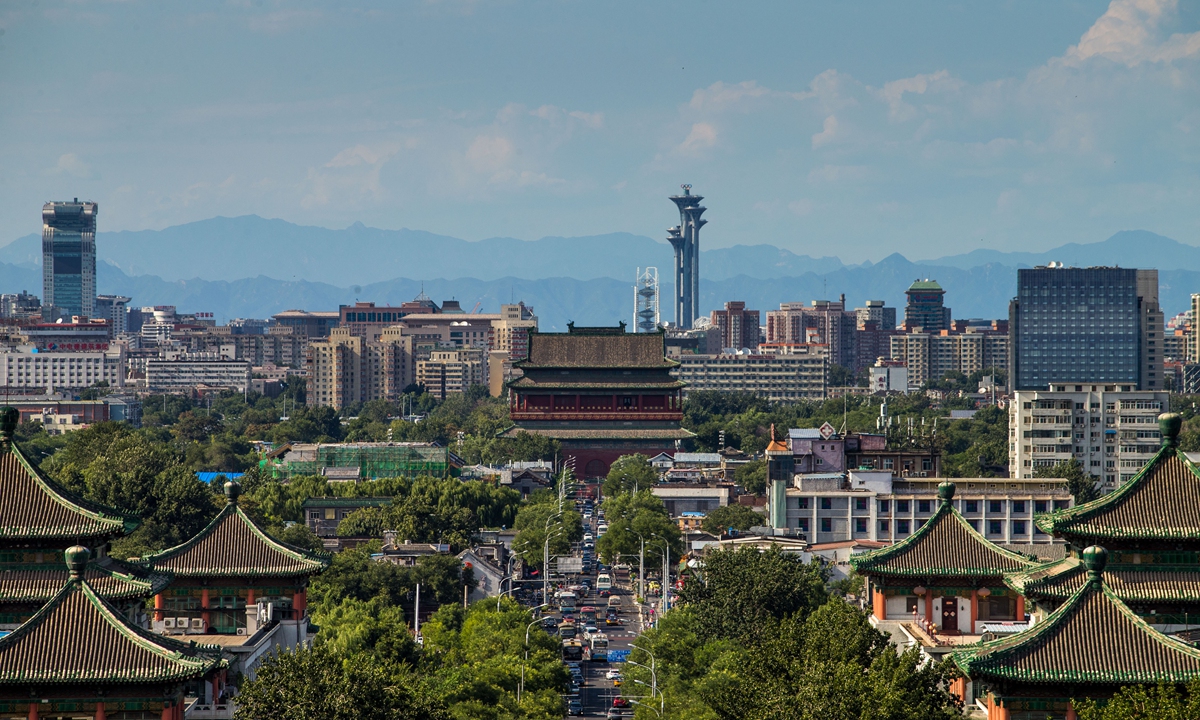
Blue sky of Beijing Photo: Li Hao/GT
China's environment, including the air quality, continued to improve in 2021, the inaugural year of the 14th Five-Year-Plan (2021-25) thanks to country's efforts to beat the air pollution in past years, according to an annual report published on Thursday.
However, environmental authorities noted that efforts are still needed to further reinforce these improvements, as problems still remain such as urban air quality which is still influenced by certain meteorological factors.
China's 339 cities on average enjoyed 87.5 percent of days with good air quality in 2021, a 0.5 percent increase from the year before, according to the China Environment Report 2020 published by the Ministry of Ecology and Environment (MEE) on Wednesday.
Among the main pollutants, PM2.5 density was found at a rate of 30 micrograms per cubic meter in 2021, a 9.1 percent year-on-year drop. O3 density has declined to 137 micrograms per cubic meter, a 0.7 percent drop from 2020 rates, according to the report.
The cities in Beijing-Hebei-Tianjin region of North China saw 67.2 percent of days with good air quality in 2021, while in Beijing the percentage was 78.9, 2.1 percent more than the year before.
Carbon emissions per 10,000 yuan of GDP also dropped 3.8 percent from 2020 levels, according to the report.
"The achievements we have made should continue to be reinforced as some problems remain," Jiang Huohua, the chief at the Department of Ecological and Environmental Monitoring at MEE noted at the monthly press conference on Thursday. "For instance, urban air quality still cannot shake off the effects of the meteorological factors."
According to the report, the average temperature in China was 10.53 C in 2021, 1 C higher than average, and the highest since 1951. Meanwhile, the country's average rainfall was 672.1 mm, 6.7 percent more than usual.
According to preliminary calculations, the total energy consumption in 2021 was 5.24 billion tons of standard coal, an increase of 5.2 percent above 2020 levels. Coal consumption increased by 4.6 percent, crude oil consumption increased by 4.1 percent, natural gas consumption increased by 12.5 percent, and electricity consumption increased by 10.3 percent.
Coal consumption accounted for 56.0 percent of total energy consumption, down 0.9 percentage points from 2020; clean energy consumption such as natural gas, hydropower, nuclear power, wind power, and solar energy accounted for 25.5 percent of total energy consumption, 1.2 percentage points more than 2020.
With regards to biodiversity, the country has identified 127,950 species, including 56,000 animals, 38,394 plants, and 655 viruses. The total area of various types of nature reserves in China accounts for about 18 percent of the country's land area. The first batch of national parks, including the Sanjiangyuan National Park, the Giant Panda National Park, the Northeast China Tiger and Leopard National Park, the Hainan Tropical Rainforest National Park, and the Wuyishan National Park were officially established in 2021.
On Thursday, the MEE also published the Marine Environment Report 2021, suggesting that the marine environment remained stable that year.
However, the monitoring of radioactive substances in China's sea showed that due to Japan's dumping of contaminated water from the Fukushima nuclear power plant, the activate concentration of Cesium-137 in the seawater remained at the same level as the year before.
According to the 2020 report, Cesium-137 exceeded the erstwhile level of the Western Pacific.




